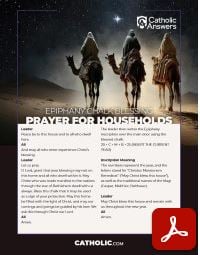
When Is Epiphany Celebrated in 2026?
The Solemnity of the Epiphany of the Lord, also known as Three Kings Day, falls on Sunday, January 4, 2026. In the Catholic tradition, Epiphany was always celebrated on January 6. Beginning with the 1970 liturgical year (which commenced on November 30,1969), the feast was moved in the United States (and elsewhere in the Latin-Rite) to the first Sunday following January 1 (i.e., from January 2-8 inclusive).
How Long Is Epiphany?
Epiphany occurs during the Christmas season. Lasting seven days, it begins on January 4, 2026 and lasts until the following Sunday, January 11, 2026.
Orthodox Epiphany
Orthodox Epiphany 2026, based on the Julian calendar, is observed later, on January 19, 2026. The Greek Orthodox are a notable exception, as they always celebrate Christmas on December 25 and Epiphany on January 6.
What Is the Significance of Epiphany in Christian Tradition?
This holy day marks the arrival of the Magi to worship the Baby Jesus and the manifestation of Christ to the Gentiles as the Savior of the world.
However, longstanding tradition connects the Epiphany with two additional events: the baptism of the Lord and the miraculous transformation of water into wine at the wedding feast in Cana of Galilee.
How Does Epiphany Relate to the Three Wise Men or Magi?
Although little is known about the Three Wise Men, tradition provides us with their names: Caspar, Melchior, and Balthasar. The Epiphany celebrates the moment Christ, the ultimate gift, was made known to the Three Wise Men and thus the Gentiles. Their journey is central to the Feast of the Three Kings 2026, highlighting the global acknowledgment of Jesus as the Messiah.
Catholic Epiphany Tradition
Tradition venerates the Three Wise Men as saints, including because they not only recognized Christ but also revealed him to the world. Their visit symbolizes the Gentiles finding Jesus (Isa. 11:10; Matt. 28:18-20) and expressing, through their gifts of gold, frankincense, and myrrh, who he is: King, God, and Savior (Isa. 60:6; Matt. 2:11). In doing so, they show that Christ himself is the greatest gift to all humanity.
What Does “Epiphany” Mean, and What Do the Gifts Brought to Jesus Symbolize?
The term “Epiphany,” based on the Greek word meaning “manifestation” or “revelation,” commemorates key events in the life of Christ: the visitation of the Three Wise Men, the baptism of Jesus in the River Jordan, and Christ’s first public miracle at Cana. Each reflects a moment of divine revelation.
Why Is the Fourth-Century Important to the Feast of the Epiphany?
The Feast of the Epiphany is rooted in the fourth-century, instituted, in part, to emphasize the universal nature of Christ’s mission. The Epiphany of the Lord 2026 calls Christians to reflect on the gifts given to Jesus: gold, symbolizing the Lord’s royalty; frankincense, used in the worship of God, signifies his divinity; and, myrrh, a burial ointment, points to Jesus’ redemptive Passion and death.
How Do Different Cultures Observe Epiphany in 2026?
Epiphany traditions vary widely:
- In the United States, Catholic families may celebrate with Epiphany chalk blessings 2026, marking their homes with a special blessing.
- Three Kings Day (Dia de los Reyes), including parades and gifts for children.
- Eastern Christians, including Eastern Catholics, focus on the baptism of Jesus, with water blessings in churches and rivers.
- In France, families enjoy the French King Cake (Galette des Rois), with a hidden figurine of Baby Jesus inside.
- Spanish-speaking countries celebrate Los Reyes Magos with festivities and Three Kings gifts for children.
What Are the Traditional Foods Associated with Epiphany Celebrations?
Epiphany is known for its festive foods, including:
- King Cake: Found in many cultures, including Mexico and the United States, this treat often includes a small figure of Baby Jesus baked inside.
- Rosca de Reyes A traditional Mexican pastry enjoyed on January 6.
Special meals like roasted meats, symbolic of the Magi’s generosity.
The Magi and the Star of Bethlehem
The Three Wise Men or Magi, often depicted as kings, witnessed the sudden appearance of a new and brilliant star (the Star of Bethlehem). This bright light indicated to the Magi the birth of an important person: in fact, a king. They didn’t literally follow the star as legend repeats. Rather, they journeyed to Jerusalem and asked Herod, “Where is the newborn king?” They were told Bethlehem. So the Magi then headed toward the star.
What Was the Star of Bethlehem?
The Star of Bethlehem was likely not a miraculous light moving across the sky, but a real astronomical event, most likely involving the planet Jupiter. Ancient Babylonian astrologers, like the Magi, would have interpreted Jupiter’s rare movements as omens signaling the birth of a new king in the region of Judea. This interpretation fits both the Gospel account and known celestial events around 2 BC, offering a historically grounded explanation for why the Magi set out in search of the newborn Messiah.
Did the Star of Bethlehem Lead the Magi?
The Star of Bethlehem did not lead the Magi in a literal or supernatural sense. While some propose that the star was a miraculous light guiding their every step, the biblical text doesn’t support this interpretation. Instead, the Magi saw the star in the east, either while they were in the east or as it rose on the eastern horizon, and understood it as a sign of a Jewish royal birth. Naturally, they traveled to Jerusalem, the logical place to find a newborn king. The fact that they had to ask for directions shows they weren’t being led by the star. After learning the prophecy pointing to Bethlehem, they set out, and only then did they see the star again. Its reappearance was a joyful coincidence, not an expected guide. Scripture describes the star as being in front of them and eventually over the place where the child was, but this fits the natural motion of a celestial object in the night sky, not a miraculous movement.
When they had heard the king they went their way; and lo, the star which they had seen in the East went before them, till it came to rest over the place where the child was.
When they saw the star, they rejoiced exceedingly with great joy. (Matthew 2:9-10)
The Star of Bethlehem and Astrology
A common challenge you may hear is, “Doesn’t the star of Bethlehem imply the practice of astrology?” The fact that the Magi recognized the Star’s significance implies that they practiced astrology, but it doesn’t imply we should.
Gifts of Gold, Frankincense, and Myrrh
The Magi brought gifts of gold, frankincense, and myrrh which symbolize:
Gold: Christ’s kingship.
Frankincense: His divinity.
Myrrh: His future sacrifice and death on the cross.
What Are the Key Epiphany Traditions Around the World in 2026?
Epiphany traditions include:
- Epiphany House Blessing 2026: Families pray for protection and grace in the coming year.
- Processions and pageants: Representing the Magi’s journey.
- Epiphany chalk blessings 2026: Marking homes with “20+C+M+B+25” as a prayer for Christ’s blessing.
Printable Epiphany House Blessing
Is Epiphany a Public Holiday in 2026, and Where?
Epiphany is a public holiday in several countries, including Spain, Mexico, and many Eastern European nations. In the United States, it is observed primarily as a religious feast day, not a public holiday.
What Is the Connection Between Epiphany and the End of the Christmas Season?
For Catholics, Epiphany marks the culmination of the traditional Christmastide celebrations, i.e., the traditional Twelve Days of Christmas (which typically don’t add up to exactly twelve in the new calendar, given that Epiphany is now a moveable feast).
Traditional Epiphany celebrations commence and overlap with the continued Christmas season, with both culminating on the Feast of the Baptism of the Lord. Christmas decorations often remain until Epiphany or the Baptism of the Lord, emphasizing the enduring joy of Christ’s birth.
The following day we transition into ordinary time.
How Can Families Celebrate Epiphany at Home in 2026?
Families can make Epiphany meaningful with:
- Epiphany blessings 2026: A prayerful home ceremony using chalk. (See our printable house blessing above.)
- Creating a Three Kings Day 2026 family feast.
- Reflecting on Bible verses about the Epiphany and discussing the Epiphany meaning.
Christ’s Revelation to the World
Epiphany 2026 is a time to celebrate Christ’s revelation to the world, offering a beautiful conclusion to the Christmas season. Whether through traditions like the King Cake, prayers, or gifts, this feast invites all to reflect on the light of Christ shining in their lives.
Related Content
Articles
Videos
Q & As
- What Is the Timeline between the Presentation in the Temple and the Fleeing to Egypt?
- When Was Jesus Born?
- The Three Wise Men in the Bible
Shop
- 20 Answers: Seasons and Feasts
- Feasts of Our Fathers
- Mystery Box Epiphany Edition
- Three Kings, Ten Mysteries



